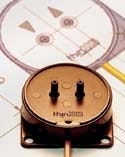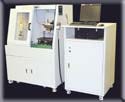June 6, 2004
Originally Published MPMNJune 2004
INDUSTRY NEWS
Microtechnology Exhibitors Create Small Sensations at Hannover Fair
NorbertSparrow
|
A micropump developed by thinXXS relies on a platform technology to speed product development and optimize production. |
One of the largest trade shows in the world, Hannover Fair in Germany continues to make room for microtechnology. Relegated to a pavilion just a few years ago, the microtechnology section now fills almost two of the fairground's enormous halls. This growth is a reflection of the sector's increasing economic importance. Analysts project that this industry will experience an annual expansion of 20%. The life sciences industry is one of the markets fueling this growth, and several exhibitors were eager to showcase the potential medical applications of their products.
One of this year's must-see exhibits is barely perceptible by the human eye. Laser Zentrum (Hannover, Germany;www.laser-zentrum-hannover.de)displayed what may well be the world's smallest jigsaw puzzle. Measuring just 5 ¥ 5 mm, the puzzle is made up of 100 pieces that are roughly the size of a small speck of dust. A remarkable achievement, to be sure, but one has to ask: why? The answer lies in the process.
The puzzle pieces were fabricated using a femto-second laser, which generates high-energy 1015-second pulses. Even though the puzzle pieces are paper, they exhibited no visible thermal damage. If afemto-second laser can do this with paper, the company asks, imagine the possibilities with other materials.
Laser Zentrum is a not-for-profit government sponsored association that conducts R&D work on lasers and related applications. In addition to micro-machining and welding applications, the lasers can be used to perform novel cleaning tasks. Medical uses include laser surgery.
One of the difficulties posed by machining miniature components arises during parts-handling operations, according to AlexKoo, managing director of Mikrotools (Singapore; www.mikrotools.com)."Handling such small parts can often cause damage," he says. When transferring the parts to another machine, addsKoo, maintaining tooling precision and calibration can also be a challenge. "That is why we developed a micromachining center that integrates several processes in one system."
The CNC center performs turning, milling, microwire electrical-discharge grinding, andmicroelectrical-discharge machining to an accuracy of ±1 µm. One of the machine's features, notesKoo, is that it can be used to fabricate electrodes, which are then used with the micromachining center to produce features on aworkpiece. Med-tech researchers are currently using the machine to manufacture neurosensors andbioconnectors, according to Koo.
For the serial production of tiny plastic parts, Jenoptik Mikrotechnik (Jena, Germany;www.jo-mikrotechnik.com) displayed its hot embossing machines. Hot embossing, which involves stamping a pattern into a softened polymer, is described as a more flexible and efficient alternative to injection molding. Microfluidic components suited for IVD use are a key application.
Jenoptik Mikrotechnik featured two machine models at the show. The HEX 02 integrates an automated press and mold-release device. The HEX 03 also includes an optical alignment system. By the end of this year, the company will launch the HEX 04 with a larger embossing area and an integrated robotic handling system.
What Lies Beneath
|
Developed by Mikrotools, a CNC micromachining |
The truly revolutionary aspect of a micropump introduced by thinXXS (Mainz, Germany;www.thinxxs.com) at Hannover Fair lies beneath the surface, says marketing manager ThomasStange. "The model MDP1304 pump that we are exhibiting here is really an evaluation kit for OEMs. While it outwardly resembles our previous model, we have made a number of engineering changes," saysStange. "The result is a platform technology that will allow us to speed up development and make production more efficient and cost-effective."
The pump can be quickly and easily adapted to suit a range of user requirements, notesStange. "The customer just needs to tell us what he wants in terms of overall dimensions, flow rate, back pressure, shape, and material properties, and the platform technology will allow us to quickly create an appropriatemicropump."
Nearby, Bartels Mikrotechnik (Dortmund, Germany; www.bartels-mikrotechnik.de)exhibited its micropump designed for serial production. With the exception of the active element, the pump is made entirely of plastic. Consequently, it is much more affordable than traditional silicon-based pumps. In fact, its cost point is so low that it can be specified for use in disposable products, says managing director Frank Bartels.
"Our goal was to keep the pump design as simple as possible," says Bartels. For example, the actuator is a piezoceramic element attached to a plastic membrane. The membrane covers a small pump chamber that is fed by dual valves; flow control can be adjusted by turning a knob on the pump or by means of aUSB-connected device.
Bartels Mikrotechnik plans to begin volume production of the micropump by the end of this year.
Piezo Technology in Motion
Affordability is also one of the selling points of a piezoelectric motor developed by Elliptec (Dortmund, Germany; www.elliptec.com).A spin-off of Siemens AG, the company has its origins in the German multinational's use of piezo technology in the automotive field.
"When Siemens used piezo technology to engineer fuel injectors at a reduced cost," says Elliptec CEO BjörnMagnussen, "we decided to take this concept a step further." By innovating on several fronts--finding a method other than grinding to process the piezo material and scaling back the complexity and quantity of electronic parts--the company was able to dramatically reduce costs. The motor's affordability along with its properties have led to considerable interest among med-tech engineers.
"The motor is very precise, accelerating and stopping almost instantly within about 10 µm, and with no backlash," saysMagnussen. "Small and lightweight, it can be used in portable devices, and it withstands harsh environments. The motor can operate submerged in fluids or in a vacuum, and it is unaffected by strong magnetic fields. In addition, it is noise-free, which is often a consideration for medical device OEMs," addsMagnussen. Several med-tech companies either are using or have shown an interest in the product, he adds, but confidentiality agreements prevent him from mentioning specifics.
Copyright ©2004 Medical Product Manufacturing News
You May Also Like




